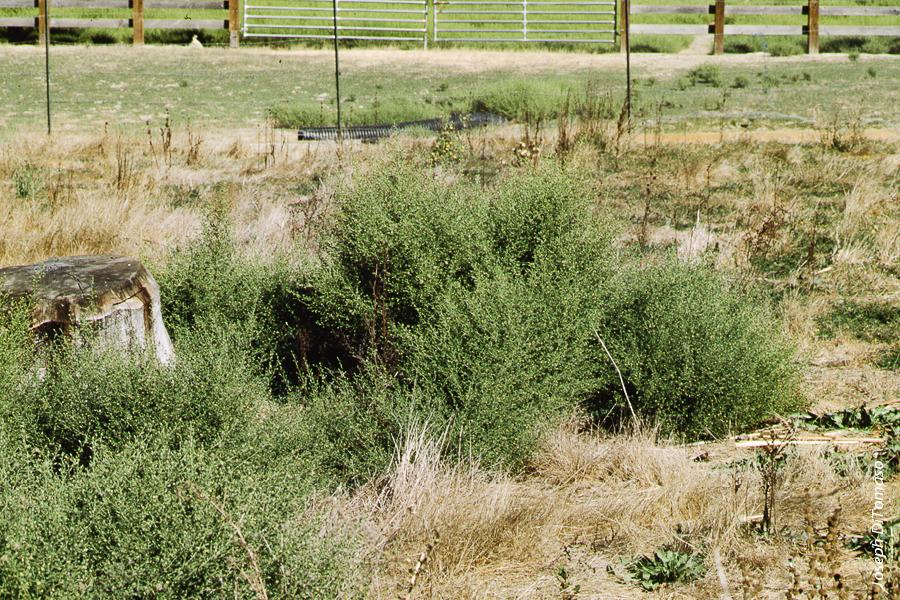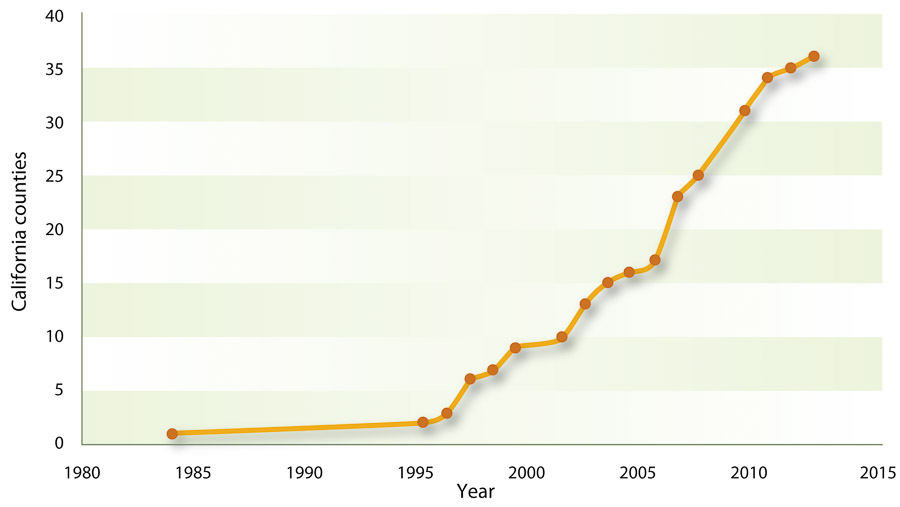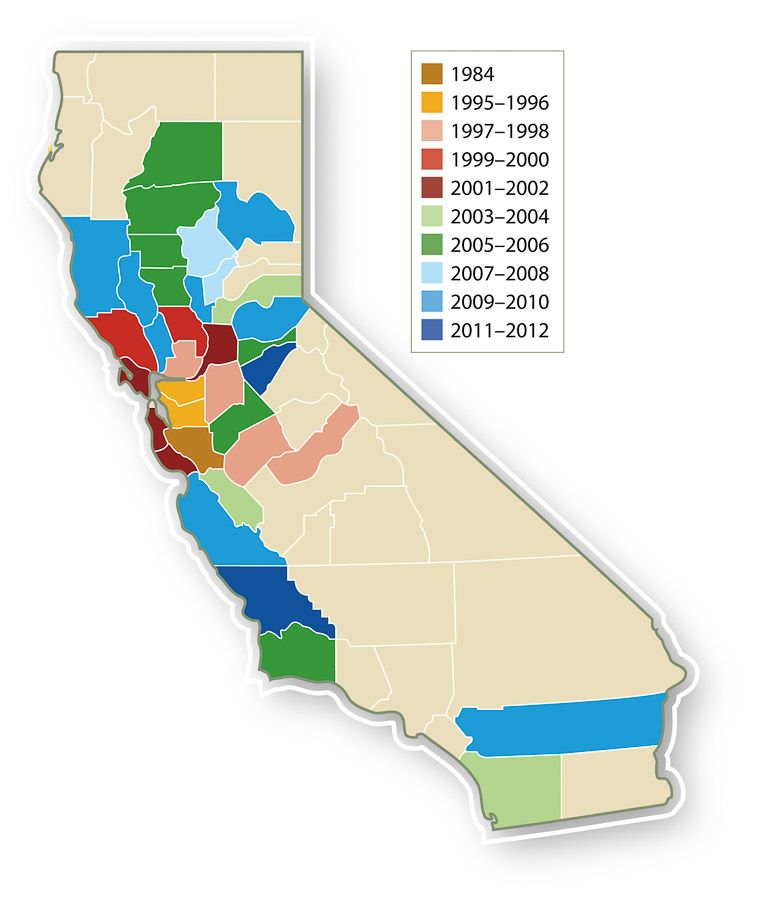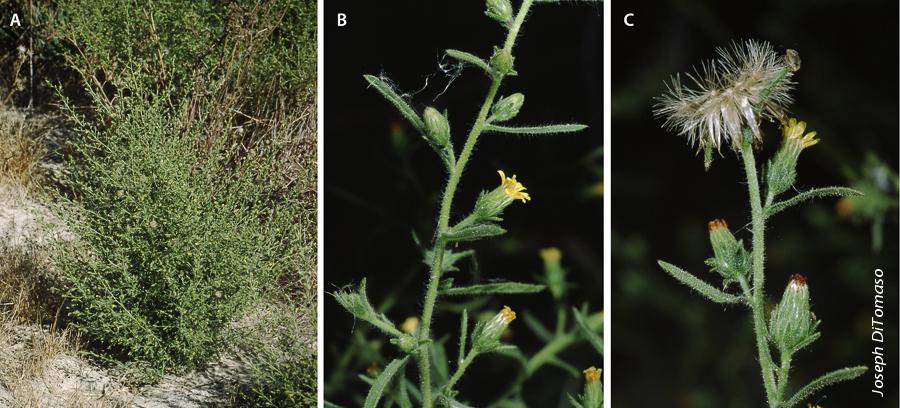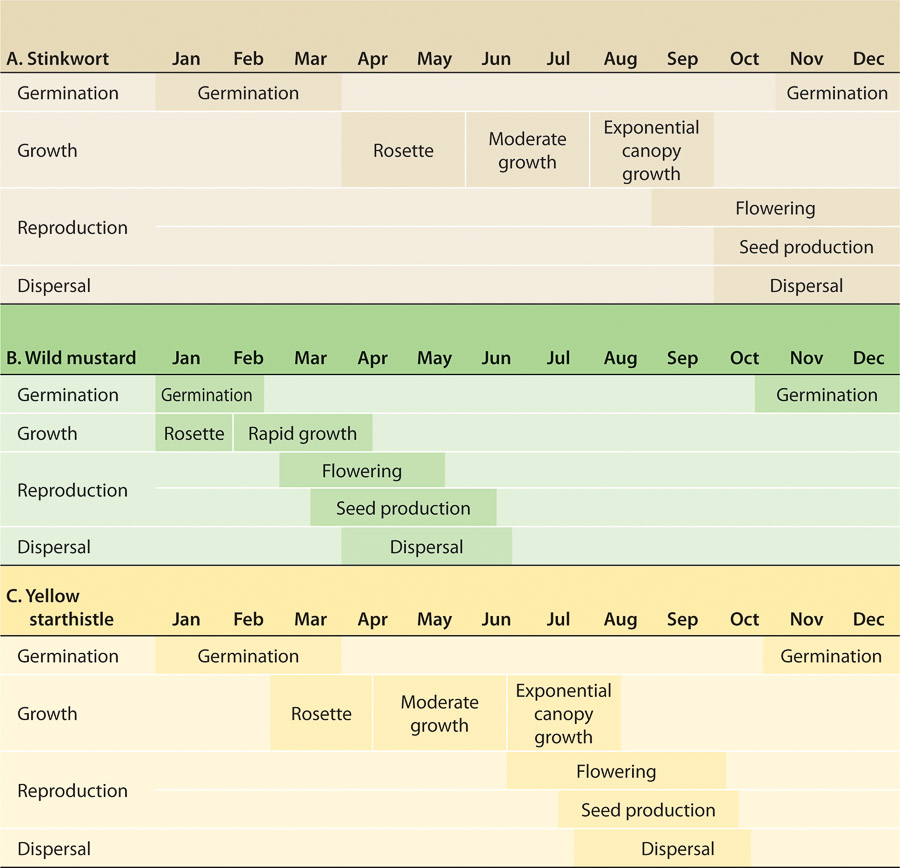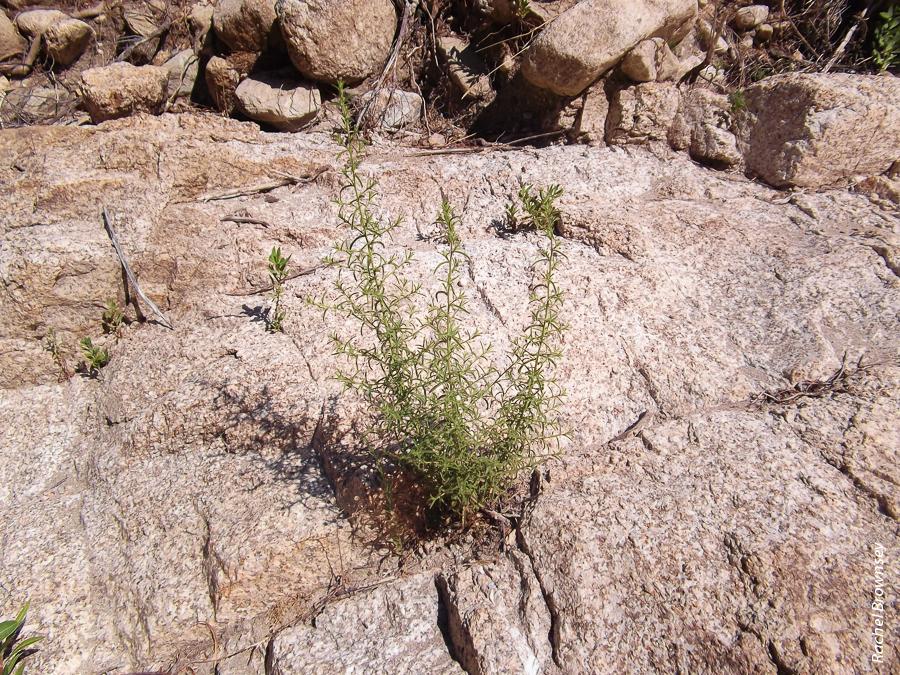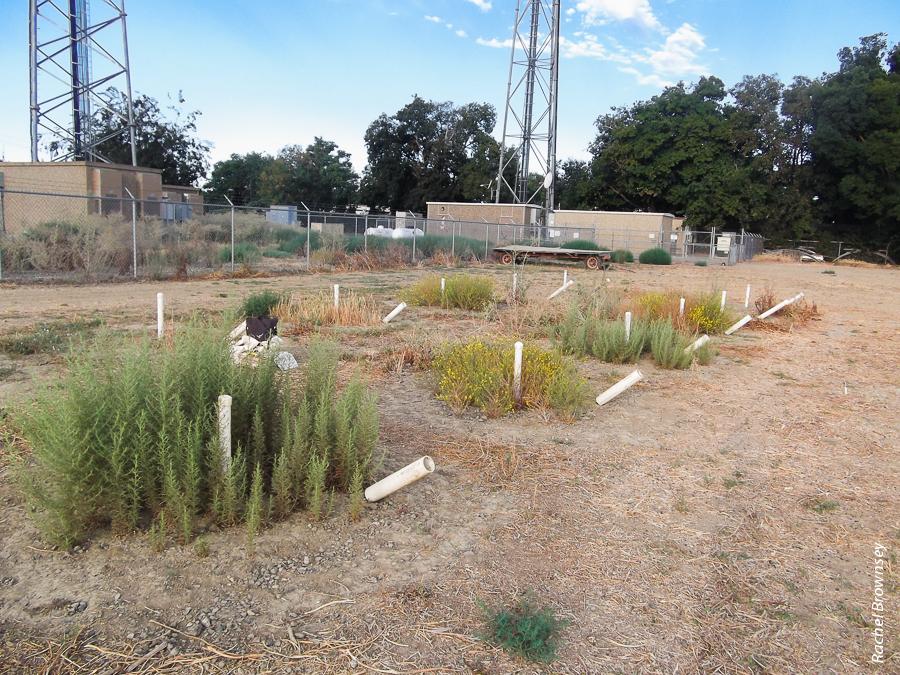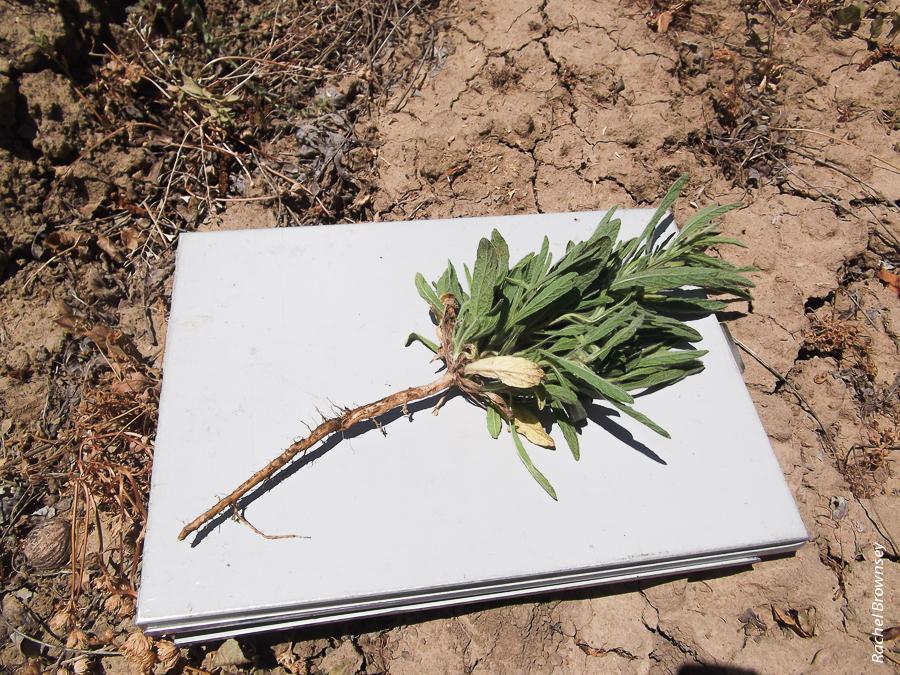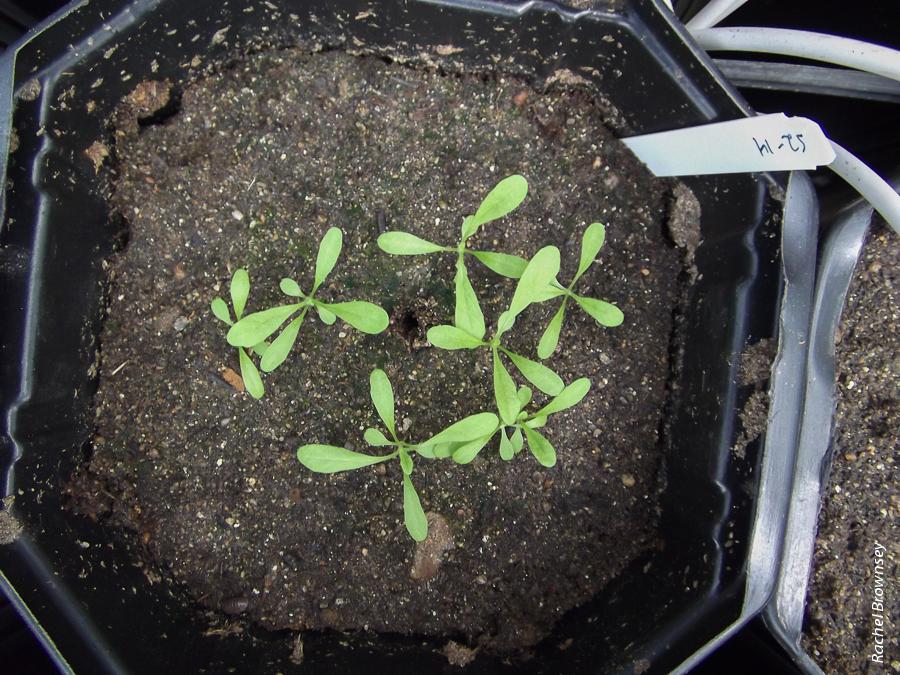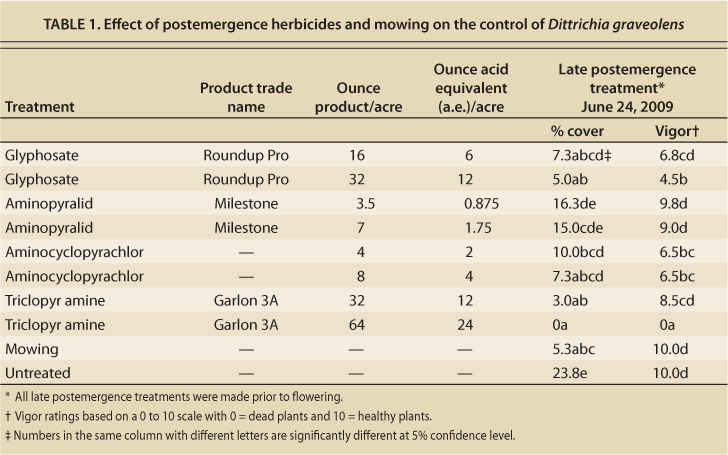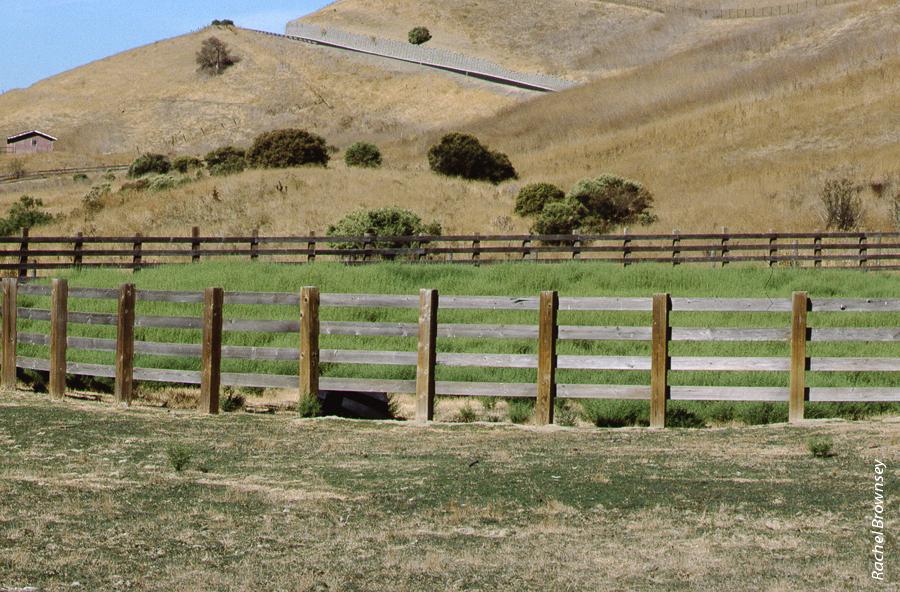All Issues
Stinkwort is rapidly expanding its range in California
Publication Information
California Agriculture 67(2):110-115. https://doi.org/10.3733/ca.v067n02p110
Published online April 01, 2013
PDF | Citation | Permissions
Abstract
Stinkwort (Dittrichia graveolens) is a Mediterranean native that has become a weed in areas of Europe as well as in Australia. This strongly aromatic weed was first reported in California in 1984 in Santa Clara County, and it had spread to 36 of the 58 California counties by 2012. Stinkwort is not palatable to animals, and can be poisonous to livestock and cause contact allergic dermatitis in humans. In California, this weed is found primarily along roadsides. However, the biology of this annual plant suggests that it could also invade open riparian areas and overgrazed rangelands. Stinkwort has an unusual life cycle among annual plants: Unlike most summer or late-season winter annuals, stinkwort flowers and produces seeds from September to December. Such basic biological information is critical to developing timely and effective control strategies for this rapidly expanding weed.
Full text
Dittrichia graveolens (L.) Grueter, commonly known as stinkwort, is a member of the Asteraceae, or sunflower, family. This plant is native to the Mediterranean region of Europe, occurring as far east as Turkey, Afghanistan and Pakistan (Brullo and de Marco 2000; Qaiser and Abid 2005). Stinkwort is an erect, fall-flowering annual that can grow about 2.5 feet tall. Its foliage has sticky glandular hairs covered in resin. The resin emits a strong aromatic odor that resembles the smell of tarweeds. The flowerheads are 0.2 to 0.3 inch (5 to 7 millimeters) in diameter and consist of short yellow ray flowers on the outer edge and yellow to reddish disk flowers in the center. Stinkwort is closely related to fleabanes, horseweed (Erigeron; formerly Conyza), goldenasters and telegraphweed (Heterotheca), but it also closely resembles the tarweeds (Centromadia spp., Hemizonia spp. and Holocarpha spp.). From a distance, stinkwort can resemble Russian-thistle (Salsola tragus L.), also called tumbleweed. Because it is fairly unattractive and nondescript in appearance, stinkwort initially passed unnoticed by many botanists and weed managers, and it was not included in the 1993 edition of The Jepson Manual of California flora (Hickman 1993).
Stinkwort is related to fleabanes and goldenasters and grows to about 2.5 feet tall. In California, this rapidly invading weed most often occurs in disturbed and wasteland sites.
In its native range and some introduced regions, stinkwort inhabits riparian woodlands, margins of tidal marshes, vernal pools and alluvial floodplains, although it has not yet invaded these wildland areas in California. In California and other introduced areas of the world, stinkwort is most often found in disturbed places, such as overgrazed rangelands, roadsides, pastures, wastelands, vineyard edges, gravel mines, levees, washes and mining sites, although in California it is seldom found in rangelands or pastures (DiTomaso and Healy 2007; Higueras et al. 2003). Stinkwort grows best on well-drained, sandy or gravelly soils and thrives in areas with hot, dry summers but can also do well along the margins of wetlands. In addition, this plant tolerates a variety of soil types and survives under a range of soil conditions, temperatures and precipitation regimes (Preston 1997). When adequate moisture is available, stinkwort can even survive on serpentine or saline soils. In Europe, this plant was shown to tolerate and to possibly hyper-accumulate heavy metals, including mercury, zinc and copper (Higueras et al. 2003; Shallari et al. 1998).
Worldwide invasion
While stinkwort is native to the Mediterranean region, including Egypt and other areas of North Africa, this species has also been introduced to several European countries where it is not native. Within the last two decades, this weed has been spreading rapidly along the highways of Central Europe. In summer 2008, stinkwort was detected for the first time in Slovenia and Austria (Frajman and Kaligaric 2009). Outside of Europe, stinkwort has been reported as an invasive species in Australia (Parsons and Cuthbertson 2001) and South Africa (South African National Biodiversity Institute 2009).
Stinkwort is not considered as a palatable species to animals. In fact, it is reported to cause poisoning in livestock (Philbey and Morton 2000). Although livestock mortality is rare, it appears to be due to enteritis caused by the barbed pappus bristles on the seed, which can puncture the small intestine wall (Philbey and Morton 2000). Stinkwort can also cause contact allergic dermatitis in humans (Thong et al. 2008). However, impacts to wildlife, natural ecosystems and working landscapes have not been broadly characterized. This is likely due to its very recent introduction and expansion in California and to the lack of published information on the species elsewhere in the world.
Rapid spread in California
The first record of Dittrichia graveolens in California is a collection made in 1984 near Milpitas in Santa Clara County (HOT Harvey s.n., University of California Jepson Herbarium/JEPS). Although the initial mechanism and time of introduction of stinkwort in the state are not documented, many of the earliest collections were made in the south and east San Francisco Bay Area (Preston 1997). Stinkwort has since spread to numerous counties in California, and many additional herbarium collections have been made throughout the state (Consortium of California Herbaria 2012).
Using the Consortium of California Herbaria records, we determined the rate of stinkwort's spread since the first discovery in Santa Clara County. Based on collection date and location data from herbarium records, this weed invasion appears to have had only a brief lag period and to have expanded at an exponential rate over the past 18 years (fig. 1). This has caused increased concern among resource managers across the state. Although it is still uncommon in many places where it is found, stinkwort has been reported in 36 of the 58 California counties (figs. 1 and 2).
Fig. 1. Approximate rate of spread of Dittrichia graveolens in California as represented by the number of California counties where plant collections have been made between 1984 and 2012 (Consortium of California Herbaria 2012).
Stinkwort seeds are likely spread by wind, on the fur and feathers of mammals and birds and on motor vehicles and equipment, thus moving along transportation corridors. While the primary expansion has moved radially from the original infestation in Santa Clara County, unconnected populations have also been discovered in San Diego and Riverside counties (fig. 2). This is likely due to either separate introductions or long-distance movement on vehicles.
Unusual life cycle
Stinkwort has very high seed viability, with an average of about 90% of the seeds capable of germination at the time they disperse from the plant. There does not appear to be primary dormancy in the seeds, which is defined as a seed that is dormant at the time it disperses from the plant (Brownsey 2012). These traits, combined with the small seed size, suggest that seed longevity in the soil should be relatively short, perhaps 2 to 3 years. Seeds are capable of germinating at nearly any time of year in the field, but they typically germinate throughout winter and early spring following periods of precipitation. We have shown that germination is limited by soil moisture, rather than soil temperature or low light conditions (Brownsey 2012). When seeds germinate in winter, the plants remain as small rosettes until mid-May During late spring and summer, they develop into pyramid- or sphere-shaped plants that superficially resemble Russian-thistle.
Stinkwort (A) is a late-season winter annual. The aromatic leaves (B) have sticky hairs covered in resin. Flowering (C) occurs late summer, in response to day length.
What makes stinkwort's life cycle rather unusual is that it matures much later in the season than most annuals, even other late-season winter annuals (fig. 3). For example, yellow starthistle begins to send up a flowering shoot (bolt, referred to as moderate growth in figure 3C) in April, begins flowering in late June, and — like most late-winter or summer annuals — has completed its life cycle by September or October. In contrast, stinkwort begins to bolt in mid-May (moderate growth in figure 3A), grows most of its branches and leaves between June and September and flowers and produces seeds from September to December. Flowering in stinkwort appears to be controlled by photoperiod (day length), as all plants initiate flowering at the same time regardless of when they germinated (Brownsey 2012).
Fig. 3. Life cycle of (A) stinkwort (Dittrichia graveolens), a late-season winter annual, compared to the life cycles of (B) wild mustard (Sinapis arvensis L.), a typical early-season winter annual, and (C) yellow starthistle (Centaurea solstitialis L.), a typical late-season winter annual.
Aside from the tarweeds, there are few other late-season winter annual species with a similar life cycle in the native California flora. Some other weedy species, such as Russian-thistle, horseweed (Conyza canadensis (L.) Cronquist) and yellow starthistle (Centaurea solstitialis L.), have similar life history strategies, with only Russian-thistle and horseweed flowering within the same time frame as stinkwort. In contrast to stinkwort, Russian-thistle is a summer annual that germinates in spring.
Stinkwort tolerates a variety of soil types and can germinate at almost any time of year. Germination is limited only by soil moisture.
Impacts in California
The environmental and economic impacts of stinkwort in California have not been fully realized and are largely unknown. Our greenhouse studies have shown that stinkwort is dramatically suppressed when grown under shaded conditions, even at 50% light (Brownsey 2012). Thus, like yellow starthistle, stinkwort is not expected to be competitive in understory communities of woodland and forest ecosystems. However, stinkwort can form dense infestations along highways and in open disturbed areas. In addition, while the establishment of this weed in undisturbed wildlands and rangelands is currently very limited in California, invasion of such areas over time is likely based on the pattern of spread in Australia.
We are now conducting studies comparing the belowground growth and development of stinkwort with two other common grassland annual species: yellow starthistle and virgate tarweed (Holocarpha virgata [A. Gray] D.D. Keck). Yellow starthistle is an invasive winter annual, and virgate tarweed is a native species that, like stinkwort, is a late-season winter annual. The goal is to determine whether stinkwort shares the characteristics of yellow starthistle and virgate tarweed that allow them to compete with shallow-rooted grasses. These characteristics are a rapid rate of root growth and deep soil root penetration.
In an experiment using a minirhizotron camera, stinkwort (left) root growth was tracked over time and compared to the root growth of yellow starthistle and the native virgate tarweed.
Initial results indicate that while stinkwort does eventually grow roots as deep as yellow starthistle and virgate tarweed, this occurs several weeks after these other grassland annuals grow their roots. Thus, it may be that stinkwort will not be a significant invasive plant of rangelands, except in years when there is significant late-season rain or when competitive winter annual species are removed by overgrazing. Nevertheless, we have observed stinkwort in open riparian systems, where water is not a limiting factor and a slow-growing shallow root system will not limit its competitive ability. It is possible that this nonnative species may eventually become a problematic weed in these more-open wetland areas.
Stinkwort can grow roots as deep as those of yellow starthistle, though it generally roots more shallowly and grows more slowly.
Current control methods
The challenge in controlling stinkwort is applying the appropriate management at the proper time. Although traditional methods of control, including mechanical and chemical techniques, can be effective, determining the most appropriate timing has been difficult. If management actions are not taken before plants begin to produce seeds in the fall, there is a risk that they will help disperse seeds rather than control stinkwort populations. For example, mowing may move seeds on equipment for long distances when conducted too late in the season. Unfortunately, a poor understanding of the biology of this plant and of how to control it effectively have led to unsuccessful management of growing infestations as well as much wasted time and money. However, management tools that prevent seed production for 1 to 2 years have the potential to greatly reduce the soil seedbank and, thus, the population size.
Biological or cultural practices.
There are currently two biological or cultural practices that can be employed to limit the ability of stinkwort to invade an area. One is to minimize disturbances such as overgrazing and soil manipulation in natural and rangeland sites. Second, pastures should be managed for dense, competitive stands of desirable perennial or annual grasses that maximize ground cover in spring, when stinkwort seedlings are beginning to establish.
Seedlings of stinkwort can be controlled by hoeing or pulling, though protective clothing should be worn because the plant can cause dermatitis.
Mechanical practices.
Mechanical control options can take advantage of the stinkwort root system, which is slow growing and initially relatively shallow. Plants may be controlled by hoeing or pulling. However, because stinkwort can cause dermatitis, it is important to wear appropriate protective clothing (long sleeves, long pants, gloves) to minimize exposure to the irritating oils. Once in flower, stinkwort plants should be bagged and removed from the site to prevent seeds from maturing and dispersing after the plants have been cut and left on the soil surface. Mowing can provide partial control when conducted late in the season (table 1). However, buds remaining on branches below the level of the mower may regrow. Mowing a second time can give improved control, especially when conducted after the soil has dried out in mid- to late summer. In contrast, mowing too early, as is done on highways to reduce the threat of grass fires, will favor stinkwort by removing competing annuals while this weed is still small and lower than the mowing blades.
Postemergence herbicides.
Postemergence herbicides are applied to small germinated seedlings or young plants. Thus, in contrast to preemergence herbicides that are generally applied to larger areas before seeds germinate, postemergence applications can directly target known infestations visible to the applicator. However, the sticky oils on the foliage, especially on mature plants, make it difficult to control stinkwort with postemergence herbicides. To overcome this, it may be necessary to use ester formulations of postemergence phenoxy-type herbicides (2,4-D, MCPA, triclopyr, etc.). However, these compounds are more volatile compared to salt formulations (commonly used in summer), and some should not be applied when ambient temperatures will reach or exceed 80°F.
In experiments we conducted for the postemergence control of stinkwort, we found that the salt formulation of triclopyr at 24-ounce acid equivalent (a.e.) per acre (2 quarts Garlon 3A per acre) gave the most effective level of control following a postemergence application (table 1). Triclopyr is selective and relatively safe on grasses, but it must be used cautiously around vineyards, as grapevines are extremely sensitive to triclopyr drift. It is also important to note that control with postemergence herbicides is most effective when plants are young, actively growing and not exposed to stresses such as drought. For stinkwort, this is generally just before or at the time of bolting.
Glyphosate (Roundup Pro) at 1 quart product per acre also gave fairly good control, and anecdotal information from other land managers indicates that a rate of 2 quarts product per acre gives control similar to triclopyr at 2 quarts product per acre. Unfortunately, other herbicides, including aminopyralid (Milestone) and aminocyclopyrachlor (one of the active ingredients in herbicide Perspective), did not provide effective late-season postemergence control of stinkwort. As previously discussed, plants also partially recovered from late-season mowing.
Dense stand of stinkwort in an overgrazed pasture. Stinkwort has spread exponentially in California since its discovery in Santa Clara County in 1984.
Pre- and early postemergence herbicides.
Because stinkwort germinates throughout the rainy season, the most effective control options are likely to be broadleaf selective herbicides with both pre- and early postemergence activity, which can control both new germinants and young emerged seedlings. A fairly new group of foliar- and soil-active growth regulator herbicides have proven very effective in winter and spring applications for control of yellow starthistle and other members of the sunflower family (Asteraceae). These herbicides have the ability to control both emerged young plants through foliar activity, as well as germinating seedlings through soil activity. These chemicals include clopyralid (Transline), aminopyralid (Milestone) and aminocyclopyrachlor, and they are generally safe on grasses. In preliminary demonstrations, we found that winter applications of aminocyclopyrachlor and spring applications of Milestone VM+ (aminopyralid plus triclopyr) showed the greatest potential for controlling stinkwort. Early-season application of glyphosate, however, controlled competing vegetation and so allowed late-germinating stinkwort to thrive. Thus, glyphosate is best used later in the season as a postemergence application.
This ongoing research is building our understanding of the life cycle and basic biology of stinkwort, allowing us to make predictions of invasion potential that will help prioritize management activities. This work also lays a foundation for future investigation of specific management methods. If we expect to stop or slow the spread of this newly invasive plant in California, we must quickly develop effective management tools and an informed management approach.



